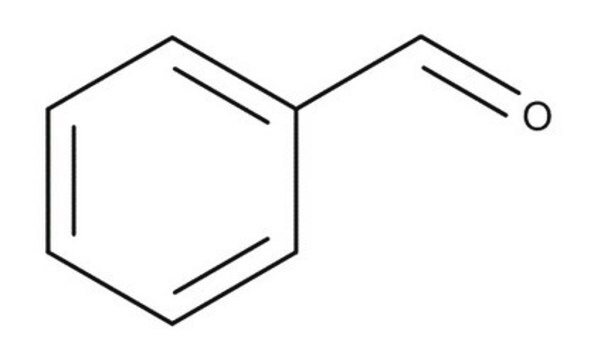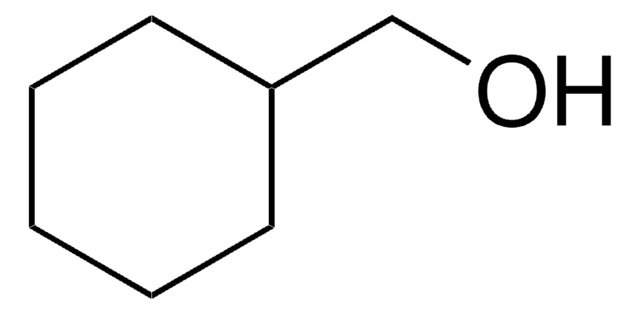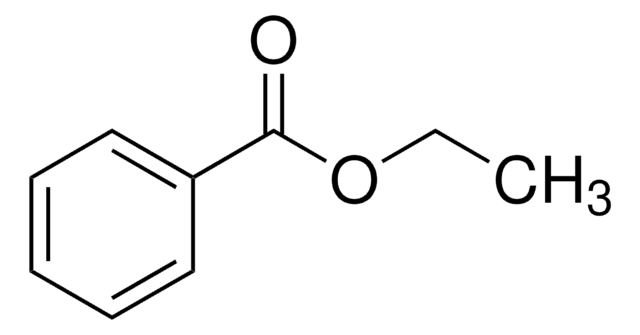PHR1203
Benzaldehyde
Pharmaceutical Secondary Standard; Certified Reference Material
Synonyme(s) :
Huile essentielle artificielle d’amandes
About This Item
Produits recommandés
Qualité
certified reference material
pharmaceutical secondary standard
Niveau de qualité
Agence
traceable to USP 1050905
Densité de vapeur
3.7 (vs air)
Pression de vapeur
4 mmHg ( 45 °C)
Famille d'API
benzaldehyde
Température d'inflammation spontanée
374 °F
Limite d'explosivité
1.4 %, 20 °F
Conditions de stockage
protect from light
Technique(s)
HPLC: suitable
gas chromatography (GC): suitable
Indice de réfraction
n20/D 1.545 (lit.)
Point d'ébullition
178-179 °C (lit.)
Pf
−26 °C (lit.)
Densité
1.044 g/cm3 at 20 °C (lit.)
Application(s)
cleaning products
cosmetics
flavors and fragrances
food and beverages
personal care
pharmaceutical (small molecule)
Format
neat
Température de stockage
2-30°C
Chaîne SMILES
O=Cc1ccccc1
InChI
1S/C7H6O/c8-6-7-4-2-1-3-5-7/h1-6H
Clé InChI
HUMNYLRZRPPJDN-UHFFFAOYSA-N
Vous recherchez des produits similaires ? Visite Guide de comparaison des produits
Description générale
Benzaldehyde is an important flavoring agent after vanillin. It is usually liberated from a cyanogenic glycoside such as amygladin, which is found in fruit kernels.
Application
Remarque sur l'analyse
Autres remarques
Note de bas de page
Produits recommandés
Produit(s) apparenté(s)
Mention d'avertissement
Danger
Mentions de danger
Classification des risques
Acute Tox. 4 Inhalation - Acute Tox. 4 Oral - Aquatic Chronic 2 - Eye Irrit. 2 - Repr. 1B - Skin Irrit. 2 - STOT SE 3
Organes cibles
Respiratory system
Code de la classe de stockage
6.1C - Combustible acute toxic Cat.3 / toxic compounds or compounds which causing chronic effects
Classe de danger pour l'eau (WGK)
WGK 1
Point d'éclair (°F)
145.4 °F - closed cup
Point d'éclair (°C)
63 °C - closed cup
Faites votre choix parmi les versions les plus récentes :
Certificats d'analyse (COA)
Vous ne trouvez pas la bonne version ?
Si vous avez besoin d'une version particulière, vous pouvez rechercher un certificat spécifique par le numéro de lot.
Déjà en possession de ce produit ?
Retrouvez la documentation relative aux produits que vous avez récemment achetés dans la Bibliothèque de documents.
Les clients ont également consulté
Protocoles
-Tolualdehyde; Valeraldehyde; Isovaleraldehyde
Notre équipe de scientifiques dispose d'une expérience dans tous les secteurs de la recherche, notamment en sciences de la vie, science des matériaux, synthèse chimique, chromatographie, analyse et dans de nombreux autres domaines..
Contacter notre Service technique












